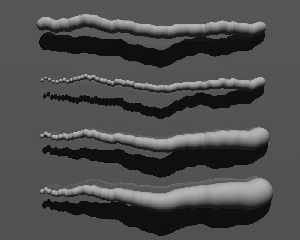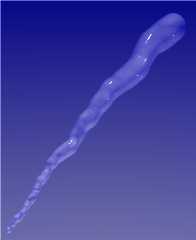 |
 |
|
 |
|
 |
|  |
|  |
|
 |
From: Christoph Hormann
Subject: Re: Off-topic picture of roots (79KB)
Date: 4 May 2001 04:04:33
Message: <3AF262AF.3B56D8D@gmx.de>
|
|
 |
|  |
|  |
|
 |
Tor Olav Kristensen wrote:
>
> Christoph: Do you have any suggestions for good web
> sites about L-systems ?
>
There are quite some useful links on the LParser homepage:
http://www.xs4all.nl/~ljlapre/lparser.htm
Another package i recently mentioned, but that is quite difficult to use
is GROGRA:
http://www.uni-forst.gwdg.de/~wkurth/grogra.html
A simple online lsystem program (in german) is availabe at:
http://www.uni-koblenz.de/~grulich/lsystem.html
A general introduction is at:
http://www.csu.edu.au/complex_systems/tutorial2.html
Christoph
--
Christoph Hormann <chr### [at] gmx de>
IsoWood include, radiosity tutorial, TransSkin and other
things on: http://www.schunter.etc.tu-bs.de/~chris/ de>
IsoWood include, radiosity tutorial, TransSkin and other
things on: http://www.schunter.etc.tu-bs.de/~chris/
Post a reply to this message
|
 |
|  |
|  |
|
 |
|
 |
|  |
|  |
|
 |
yooper: Interesting idea to leave blobs components
along a flock trail. I'll give this a thought (or two).
----------
I was thinking about how roots often grow around one another . . .
and then I flashed on how the flocking algorithum employs a
collision detection function ( just what Christoph suggested be used
with an l-system algorithm). Of course, this brings to mind your
Antiblobs . . . they also *avoid* the other components space.
I was thinking about this all night at work . . . (these things alwayz
bug me until I find a resolution ;) and I wondered if you had yet
expanded your Antiblob macro to include AntiCylinders ? I have
no experience with them and I may be wrong but . . . doesn't POVray
or MegaPOV allow cylinders to be affected by the blob thing?
If so, then it might be possible to use tapered, curved Antiblob
cylinders to simulate growth that would have that avoid feature.
Y
got tonz of ideas . . .
& no time to follow up on any of 'em. sad, ain't it ;(
but I'm happy to give them away . . . as long as someone can use them ;)
Post a reply to this message
|
 |
|  |
|  |
|
 |
|
 |
|  |
|  |
|
 |
Started thinking about placing blobs along a trail . . .
I did a blob made up of 60 spheres . . . shifting each by 0.5
along the X axis and allowing each to randomly shift a small
amount in the Y and Z axis.
The top blob is only that ... with Strength and Radius set to 1.0
and threshold at 0.2.
For the next 3 I just varied the Strength as a funtion of the count
so that it began at ~ 0.4 and ended at 0.9 for the 2nd from the
top, 1.6 for the strength of the 3rd down and 2.2 for the last.
This gave it a bit of taper . . . next I had planned on having 3
or 4 intertwine but I got sidetracked . . . started playing with
textures and ended up with an icicle sort of thing. ;)
Some lay a good ice texture on me and I'll keep playing at it.
Back to the roots tomorrow ;)
Y
Post a reply to this message
Attachments:
Download 'root2.jpg' (49 KB)
Download 'ice.jpg' (46 KB)
Preview of image 'root2.jpg'

Preview of image 'ice.jpg'

|
 |
|  |
|  |
|
 |
|
 |
|  |
|  |
|
 |
yooper wrote:
>
> yooper: Interesting idea to leave blobs components
> along a flock trail. I'll give this a thought (or two).
> ----------
>
> I was thinking about how roots often grow around one another . . .
> and then I flashed on how the flocking algorithum employs a
> collision detection function ( just what Christoph suggested be used
> with an l-system algorithm). Of course, this brings to mind your
> Antiblobs . . . they also *avoid* the other components space.
>
> I was thinking about this all night at work . . . (these things alwayz
> bug me until I find a resolution ;) and I wondered if you had yet
> expanded your Antiblob macro to include AntiCylinders ? I have
> no experience with them and I may be wrong but . . . doesn't POVray
> or MegaPOV allow cylinders to be affected by the blob thing?
> If so, then it might be possible to use tapered, curved Antiblob
> cylinders to simulate growth that would have that avoid feature.
>
> Y
> got tonz of ideas . . .
> & no time to follow up on any of 'em. sad, ain't it ;(
> but I'm happy to give them away . . . as long as someone can use them ;)
Thank you for sharing more of these ideas of
yours yooper !
I have not yet made any "cylinder antiblobs",
but maybe it will produce exiting results.
(The math wouldn't bee too difficult I think
...)
And yes: IIRC one can use cylinder
components within blobs.
But unfortunately at the moment I don't have
much time for POV-experimenting either.
=(
BTW: Are you working during the night ??
--
Best regards,
Tor Olav
mailto:tor### [at] hotmail com
http://hjem.sol.no/t-o-k/tokpicts.html
http://www.crosswinds.net/~tok com
http://hjem.sol.no/t-o-k/tokpicts.html
http://www.crosswinds.net/~tok
Post a reply to this message
|
 |
|  |
|  |
|
 |
|
 |
|  |
|  |
|
 |
David Fontaine wrote:
>
> Cool photo!
Thanks David.
> Yeah, that would take some pretty intense POVing.
And if one could work out the POV code,
I suspect it would take several eternities
to render...
--
Best regards,
Tor Olav
mailto:tor### [at] hotmail com
http://hjem.sol.no/t-o-k/tokpicts.html
http://www.crosswinds.net/~tok com
http://hjem.sol.no/t-o-k/tokpicts.html
http://www.crosswinds.net/~tok
Post a reply to this message
|
 |
|  |
|  |
|
 |
|
 |
|  |
|  |
|
 |
Christoph Hormann wrote:
>
> Tor Olav Kristensen wrote:
> >
> > Christoph: Do you have any suggestions for good web
> > sites about L-systems ?
> >
>
> There are quite some useful links on the LParser homepage:
> http://www.xs4all.nl/~ljlapre/lparser.htm
>
> Another package i recently mentioned, but that is quite difficult to use
> is GROGRA:
> http://www.uni-forst.gwdg.de/~wkurth/grogra.html
>
> A simple online lsystem program (in german) is availabe at:
> http://www.uni-koblenz.de/~grulich/lsystem.html
>
> A general introduction is at:
> http://www.csu.edu.au/complex_systems/tutorial2.html
Thank you very much for your links Christoph.
I've started reading now.
--
Best regards,
Tor Olav
mailto:tor### [at] hotmail com
http://hjem.sol.no/t-o-k/tokpicts.html
http://www.crosswinds.net/~tok com
http://hjem.sol.no/t-o-k/tokpicts.html
http://www.crosswinds.net/~tok
Post a reply to this message
|
 |
|  |
|  |
|
 |
|
 |
|  |
|  |
|
 |
Tor Olav Kristensen wrote:
>
> The photo below shows the roots of a little
> "bushy" tree I found.
>
> I find this quite fascinating and I wish
> that I could come up with a noisy pattern
> for an iso that would produce such images.
You could fake it fairly easy with a HF object but creating the base
image may be a challenge :)
--
Ken Tyler - 1400+ POV-Ray, Graphics, 3D Rendering, and Raytracing Links:
http://home.pacbell.net/tylereng/index.html http://www.povray.org/links/
Post a reply to this message
|
 |
|  |
|  |
|
 |
|
 |
|  |
|  |
|
 |
Ken wrote in message <3B009886.2947EB33@pacbell.net>...
>
>
>Tor Olav Kristensen wrote:
>>
>> The photo below shows the roots of a little
>> "bushy" tree I found.
>>
>> I find this quite fascinating and I wish
>> that I could come up with a noisy pattern
>> for an iso that would produce such images.
>
>You could fake it fairly easy with a HF object but creating the base
>image may be a challenge :)
>
>--
>Ken Tyler - 1400+ POV-Ray, Graphics, 3D Rendering, and Raytracing Links:
>http://home.pacbell.net/tylereng/index.html http://www.povray.org/links/
Indeed. Heightfields work great! See my post below. Creating the image isn't
actually all that difficult, but it is still takes some work.
----------------------------------------
Batronyx ^"^
bat### [at] cadronhsa com
http://www.batronyx.com
Bhuddist monk to hotdog vendor:
"Make me one with everything."
---------------------------------------- com
http://www.batronyx.com
Bhuddist monk to hotdog vendor:
"Make me one with everything."
----------------------------------------
Post a reply to this message
|
 |
|  |
|  |
|
 |
|
 |
|  |
|  |
|
 |
I think you should take a look at Kevin Wamplers sig...
#version unofficial MegaPov 0.6;camera{location-z*8direction z*2look_at 0}
light_source{<-2,5,-2>*1e3 rgb 1}%K=text{ttf"cyrvetic.ttf""KEVIN".25,0
translate-1.5*x scale 1.5}%G=pigment{rgb<.8,.6,.4>}%R=seed(0);#macro B()<rand(
R)-.5,rand(R)-.5,rand(R)-.5>#end#macro A(C)%T=0;%V=<0,1,0>;#while(T<250)%S=0;%
P=B();%U=trace(K,C,P)-C;#while(S<15)%P1=B();%W=trace(K,C,P1)-C;#if(vlength(W)
<vlength(U))%P=P1;%U=trace(K,C,P)-C;#end%S=S+1;#end%V=V+P;%V=V/vlength(V);%D=(
250-T)/1e4;union{cylinder{C,C+V*.03,D}sphere{C,D}triangle{C,C+B()*D*10,C+B()*D
*4 pigment{rgb<0,.7,0>}}pigment{G}no_shadow}%C=C+V*.03;%T=T+1;#end#end%N=0;
#while(N<35)A(<(rand(R)-.5)*3, 0, rand(R)/4>*1.7)%N=N+1;#end // Kevin Wampler
Nekar
--
#local N=<-20,40,100>;#local K=<20,-40,100>;#local R=seed(0);blob{#while((K-N).
x>0)#local X=N;#local N=N+<rand(R),rand(R),1>/3;#local N=(vlength(N-K)<vlength(
X-K)?N:2*X-N);sphere{<N.y,-N.x,N.z>,1,1 scale .02}sphere{N,1,1 scale.02}sphere{
<-N.x-40,N.y,N.z>1,1 scale.01}sphere{<N.x+40,-N.y,N.z>1,1 scale.01 }#end
pigment{rgbt 1}interior{media{emission <2,4,5>*5}}hollow}// Nekar Xenos
"Tor Olav Kristensen" <tor### [at] hotmail com> wrote in message
news:3AF08D55.6B22895D@hotmail.com...
>
> The photo below shows the roots of a little
> "bushy" tree I found.
>
> I find this quite fascinating and I wish
> that I could come up with a noisy pattern
> for an iso that would produce such images.
>
> Hope this is not too off-topic.
>
>
> --
> Best regards,
>
> Tor Olav
>
> mailto:tor### [at] hotmail com> wrote in message
news:3AF08D55.6B22895D@hotmail.com...
>
> The photo below shows the roots of a little
> "bushy" tree I found.
>
> I find this quite fascinating and I wish
> that I could come up with a noisy pattern
> for an iso that would produce such images.
>
> Hope this is not too off-topic.
>
>
> --
> Best regards,
>
> Tor Olav
>
> mailto:tor### [at] hotmail com
> http://hjem.sol.no/t-o-k/tokpicts.html
> http://www.crosswinds.net/~tok
-------------------------------------------------------------------------------- com
> http://hjem.sol.no/t-o-k/tokpicts.html
> http://www.crosswinds.net/~tok
--------------------------------------------------------------------------------
Post a reply to this message
|
 |
|  |
|  |
|
 |
|
 |
|  |
|  |
|
 |
yooper wrote:
> I'm wondering if one calculated the positions of the objects
> using a "flocking" algorithm as used in some ALife progs . . .
> and placed spheres or blobs (or Antiblobs !!!) along each trail,
> if the traces of their intertwining routes would look come anywhere
> close to your pattern.
Unfortunately there's nothing to keep the trails from intersecting.
--
Anton Sherwood -- http://www.ogre.nu/ (online again, Nov.19)
Post a reply to this message
|
 |
|  |
|  |
|
 |
|
 |
|  |




![]()